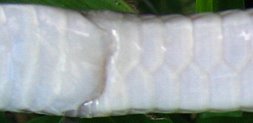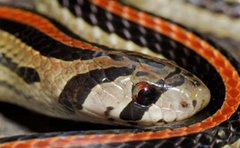Lai Chien-Houng opened the door and a House Wolf Snake (Lycodon capucinus) fell onto the floor. This snake is THAT common (relative to other species) in buildings, probably because their food, geckos, are also abundant in this type of habitat. However, this species is still rarely encountered by people because of their secretive nature. Fortunately to us, it is neither venomous nor dangerous. This encounter, occurred in the TMSI (Tropical Marine Science Institute) compound at St. John's Island on 24 September 2007, made our day. We took some photographs and released it soon after that. The following photographs were taken by Lim Swee Cheng.



Photographs from top to bottom: A small individual (probably a few weeks old) in my hand; Right side of head; Dorsal side of head.
There were more photographic records of this snake in the past year, most of which occurred in buildings. I am glad to know that the harmless snakes were either left alone or released after cautious handling, instead of killed at first sight.

Matt Tench found this snake (pictured above), with an estimated body length of 8 inches, in the bathroom of Bungalow 53 at St. John's Island on 22 April 2007. He got it onto a long handled dustpan and set it free in the wild.

Peter Karlsson found this snake (pictured above), with an estimated body length of 40 cm, at Serangoon Gardens on 10 March 2007. The snake was under some rooftiles that were placed on the floor. He left the snake alone.

This snake (pictured above) was photographed by Ron Yeo at Pulau Hantu on 4 March 2007.

A friend of Gail Q, who lives near Kent Ridge Bus Terminal, found this snake (pictured above) at the doorsteps of his house on 18 October 2006 at about 6pm. He kept the snake in a pail because he wanted to know its identification (after consulting me) before releasing it.

A cleaner found this snake (pictured above) in the NIE (National Institute of Education) canteen on 1 September 2006. He picked it up with a thong, kept it in a plastic bag and passed it to me. It was released.
More records of this snake here and here.












